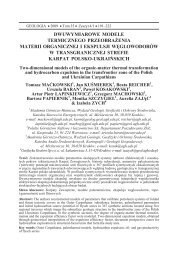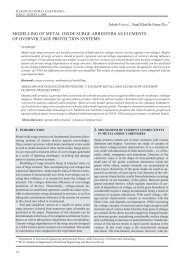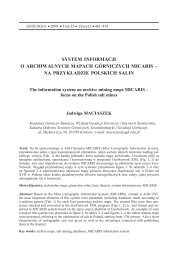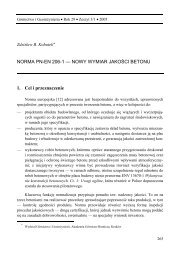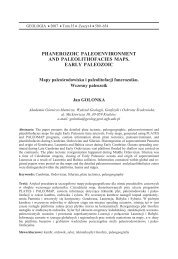Create successful ePaper yourself
Turn your PDF publications into a flip-book with our unique Google optimized e-Paper software.
120 J. Wachowiak, M. Pawlikowski & P. Wilkosz<br />
RESULTS<br />
Boreholes Z-9 and Z-17 were drilled through Zechstein salt series formations, composed<br />
of a thick rock salt complex, with small potash-magnesium salt, sulphate rock (anhydrites)<br />
and evaporite-silicoclastic (zubers and clayey salts) layers (Figs 3, 4).<br />
Four main types of rocks were identi ed in the cores:<br />
– rock salts,<br />
– potash-magnesium salts,<br />
– zubers and clayey salts,<br />
– anhydrites.<br />
Rock salts<br />
Rock salts were represented by units of various petrographic types described below.<br />
White and white-grey rock salts belong to the deposits of the PZ-2 cyclothem. They<br />
are the dominating rocks in the cores of the two boreholes. They occurred in the whole<br />
core interval (Figs 3, 4), together with rare, thin shoals of other evaporite rocks, described<br />
below. In borehole Z-17, white rock salts occurre from 600 m to 1,695 m and above, in<br />
the interval of 600–247 m, and these were described on the basis of chip samples. In borehole<br />
Z-9, white rock salts occurred from 800 m to 1,530 m. They are also found in chip<br />
samples in shallower depths.<br />
The white and white-greyish colour of those salts are changing in hues, from light white,<br />
sometimes transparent, milky white, white and grey-yellowish to grey-whitish and dark grey.<br />
Darker hues were associated with the increased proportion of insoluble parts, mainly those<br />
dispersed in the salt mass of anhydrite grains. Despite clear macroscopic differences between<br />
particular variations, we observed sedimentational continuity (smooth changes between<br />
layers), which indicated linear changes of the sedimentation conditions or recrystallization<br />
of those formations. Those salt structures were diverse, from ne-blastic (with blasts<br />
below 2 mm) to coarse-blastic (with blasts above 20 mm) or crystalline, with halite crystals<br />
of up to 9 cm. Neither of the described salt varieties was characterized by a speci c structure,<br />
although medium- and coarse-blasts of 2–20 mm were found in the large majority of structures.<br />
The halite blasts were usually irregular, and the contact between them was not even.<br />
White and white-greyish rock salts mostly displayed directional parallel textures, marked with<br />
the lamination of several millimetre anhydrite trails, separated from several to about a dozen<br />
of centimetres from each other and a directional layout of elongated halite blasts, complying<br />
with shaoling. We also found less frequent stripped directional textures, with clear boundary<br />
between coarse-blastic (10–30 mm) and medium-blastic (2–10 mm) strips. The texture of salts<br />
with yellow-orange hues (the so-called esh-coloured salt) was poorly compacted. That feature<br />
clearly distinguished them from typical white-greyish rock salts, which displayed compacted<br />
and massive textures. Some portions of white rock salt did not have clear lamination.



